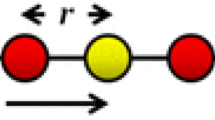Abstract
This paper describes a model of three-dimensional cellular automata allowing to simulate different phenomena in the fields of computer graphics or image processing. Our method allows to combine them together in order to produce complex effects such as automatic texturing, surface imperfections, or biological retina multi-layer cellular behaviours. Our cellular automaton model is defined as a network of connected cells arranged in a natural and dynamic way, which affords multi-behavior capabilities. Based on cheap and widespread computing systems, real-time performance can be reached for simulations involving up to a hundred thousand cells. The efficiency of such an approach is illustrated by a set of CA related to computer graphics –e.g. erosion, sedimentation, or vegetal growing processes– and image analysis –e.g. retina simulation.
Preview
Unable to display preview. Download preview PDF.
Similar content being viewed by others
References
Curtis, C.J., Anderson, S.E., Seims, J.E., Fleischery, K.W., Salesin, D.H.: Computer-generated watercolor. In: SIGGRAPH 1997 Conf. Proc., vol. 24, pp. 225–232 (1997)
de Berg, M., Schwarzkopf, O., van Kerveld, M., Overmars, M.: Computational Geometry: Algorithms and Applications, 2nd edn. Springer, Berlin (1998)
Devillard, F., Gobron, S., Grandidier, F., Heit, B.: Implémentation par automates cellulaires d’une modélisation architecturale de rétine biologique. In: READ 2005, Institut National des Télécommunications, Evry, France, June 1-3 (2005)
Druon, S., Crosnier, A., Brigandat, L.: Efficient cellular automaton for 2d / 3d free-form modeling. Journal of WSCG 11 (2003) (1, ISSN 1213-6972)
Duchting, W.: Tumor growth simulation. Computers and Graphics 14(3/4), 505–508 (1990)
Even, P., Gobron, S.: Interactive three-dimensional reconstruction and weathering simulations on buildings. In: CIPA 2005 XXth International Symposium, Turin, Italy, pp. 796–801 (2005)
Gerhardt, M., Schuster, H., Tyson, J.J.: A cellular automaton model of excitable media including curvature and dispersion. Science 247, 1563–1566 (1990)
Gobron, S., Chiba, N.: 3D surface cellular automata and their applications. The Journal of Visualization and Computer Animation 10, 143–158 (1999)
Gobron, S., Devillard, F., Heit, B.: Real-time contour restoration and segmentation using cellular automaton and GPU programming (in reviewing process) (2006)
Gobron, S., Finck, D.: Generating surface textures based on cellular networks. In: The Geometric Modeling and Imaging international conference (GMAI 2006), IEEE Computer Society Press, Los Alamitos (2006)
Harris, M.: Implementation of a CML boiling simulation using graphics hardware. In CS. Dept, UNCCH, Tech. Report, vol. 02-016 (2003)
Harris, M., Coombe, G., Scheueermann, T., Lastra, A.: Physically-based visual simulation on graphics hardware. Graphics Hardware, 1–10 (2002)
Li, W.: Complex patterns generated by next nearest neighbors cellular automata. Computers and Graphics 13(4), 531–537 (1989)
Makkuni, R.: Pixelated structures as a compositional medium. The Visual Computer 2(4), 243–254 (1986)
Mason, W.K.: Art from cellular automata and symmetrized dot-patterns. Computers and Graphics 16(4), 439–442 (1992)
Reynolds, C.: Flocks, herds, and schools: A distributed behavioral model. In: ACM Computer Graphics Conf. Proc., vol. 21(4), pp. 25–33 (July 1987)
Thalmann, D.: A lifegame approach to surface modeling and rendering. The Visual Computer 2, 384–390 (1986)
Tran, J., Jordan, D., Luebke, D.: New challenges for cellular automata simulation on the GPU (2003), http://www.cs.virginia.edu
Turk, G.: Generating texture for arbitrary surfaces using reaction-diffusion. In: SIGGRAPH 1991 Conf. Proc., vol. 25, pp. 289–298 (1991)
Wang, L., Wang, X., Tong, X., Lin, S., Hu, S., Guo, B., Shum, H.-Y.: View-dependent displacement mapping. In: SIGGRAPH 2003 Conf. Proc., vol. 22, pp. 334–339 (2003)
Witkin, A., Kass, M.: Reaction-diffusion textures. In: SIGGRAPH 1991 Conf. Proc, pp. 299–308 (1991)
Wolfram, S.: A new kind of science, 1st edn. Wolfram Media Inc. (2002)
Author information
Authors and Affiliations
Editor information
Editors and Affiliations
Rights and permissions
Copyright information
© 2006 Springer-Verlag Berlin Heidelberg
About this paper
Cite this paper
Gobron, S., Finck, D., Even, P., Kerautret, B. (2006). Merging Cellular Automata for Simulating Surface Effects. In: El Yacoubi, S., Chopard, B., Bandini, S. (eds) Cellular Automata. ACRI 2006. Lecture Notes in Computer Science, vol 4173. Springer, Berlin, Heidelberg. https://doi.org/10.1007/11861201_14
Download citation
DOI: https://doi.org/10.1007/11861201_14
Publisher Name: Springer, Berlin, Heidelberg
Print ISBN: 978-3-540-40929-8
Online ISBN: 978-3-540-40932-8
eBook Packages: Computer ScienceComputer Science (R0)




